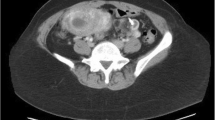Abstract
Introduction
The hormone human chorionic gonadotropin (hCG), secreted by molar tissue, is structurally similar to thyroid-stimulating hormone (TSH). Hyperthyroidism in trophoblastic disease is thought to be the result of TSH receptor activation by extremely elevated levels of hCG. Significant elevations in hCG levels are less common in cases of partial moles.
Materials and methods
We describe a patient with partial molar pregnancy in which the levels of hCG and thyroid hormones were significantly high. It was not possible to decrease the elevated thyroid hormone concentrations to safer levels using medical treatment strategies only. Since the patient’s vaginal bleeding increased gradually, plasmapheresis was used to rapidly control the thyroid hormones during the preoperative preparation of the patient for anesthesia and surgery. After the evacuation of the molar tissue, the levels of the thyroid hormones detected after the plasmapheresis started to decrease even further.
Conclusion
Plasmapheresis may be used as an alternative to antithyroid medication for the rapid control of thyroid hormones in cases of severe hyperthyroidism caused by molar pregnancy.

Similar content being viewed by others
References
Sanchez JC, Sanchez JE (1998) Pathological case of the month. Hyperthyroidism with a hydatidiform mole. Arch Pediatr Adolesc Med 152:827–828
Narasimhan KL, Ghobrial MW, Ruby EB (2002) Hyperthyroidism in the setting of gestational trophoblastic disease. Am J Med Sci 323:285–287. doi:10.1097/00000441-200205000-00012
Chiniwala NU, Woolf PD, Bruno CP, Kaur S, Spector H, Yacono K (2008) Thyroid storm caused by a partial hydatidiform mole. Thyroid 18:479–481. doi:10.1089/thy.2007.0212
Erturk E, Bostan H, Geze S, Saracoglu S, Erciyes N, Eroglu A (2007) Total intravenous anesthesia for evacuation of a hydatidiform mole and termination of pregnancy in a patient with thyrotoxicosis. Int J Obstet Anesth 16:363–366. doi:10.1016/j.ijoa.2006.12.004
Garner EI, Goldstein DP, Feltmate CM, Berkowitz RS (2007) Gestational trophoblastic disease. Clin Obstet Gynecol 50:112–122. doi:10.1097/GRF.0b013e31802f17fc
Gerulath AH, Ehlen TG, Bessette P, Jolicoeur L, Savoie R (2002) Gerulath AH, Ehlen TG, Bessette P, Jolicoeur L, Savoie R; Society of Obstetricians and Gynaecologists of Canada; Gynaecologic Oncologists of Canada; Society of Canadian Colposcopists. J Obstet Gynaecol Can 24:434–446
Tisne L, Barzelatto J, Stevenson C (1955) Study of thyroid function during pregnancy and the postpartum period with radioactive iodine. Bol Soc Chil Obstet Ginecol 20:246–251 in Spanish
Padmanabhan LD, Mhaskar R, Mhaskar A, Vallikad E (2003) Trophoblastic hyperthyroidism. J Assoc Physicians India 51:1011–1013
Langley RW, Burch HB (2003) Perioperative management of the thyrotoxic patient. Endocrinol Metab Clin North Am 32:519–534. doi:10.1016/S0889-8529(03)00010-0
Kim JM, Arakawa K, McCann V (1976) Severe hyperthyroidism associated with hydatidiform mole. Anesthesiology 44:445–448. doi:10.1097/00000542-197605000-00021
Ozbey N, Kalayoglu-Besisik S, Gul N, Bozbora A, Sencer E, Molvalilar S (2004) Therapeutic plasmapheresis in patients with severe hyperthyroidism in whom antithyroid drugs are contraindicated. Int J Clin Pract 58:554–558. doi:10.1111/j.1368-5031.2004.00140.x
Author information
Authors and Affiliations
Corresponding author
Rights and permissions
About this article
Cite this article
Adali, E., Yildizhan, R., Kolusari, A. et al. The use of plasmapheresis for rapid hormonal control in severe hyperthyroidism caused by a partial molar pregnancy. Arch Gynecol Obstet 279, 569–571 (2009). https://doi.org/10.1007/s00404-008-0762-9
Received:
Accepted:
Published:
Issue Date:
DOI: https://doi.org/10.1007/s00404-008-0762-9




